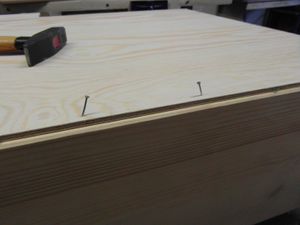Material:Nails: Difference between revisions
From CoMakingSpace Wiki
added photo of angle trick |
Further Reading - Wikipedia has tons of information on nails if you are interested... |
||
| Line 13: | Line 13: | ||
[[File:intentionally crooked nails.JPG|thumb|left|300 px|nails driven in at opposing angles can "help" each other against sliding out of the wood under load]] | [[File:intentionally crooked nails.JPG|thumb|left|300 px|nails driven in at opposing angles can "help" each other against sliding out of the wood under load]] | ||
== Further Reading == | |||
* Wikipedia | |||
** [https://de.wikipedia.org/wiki/Nagel ''Nagel (DE)''] | |||
** [https://en.wikipedia.org/wiki/Nail_(fastener) Nail (EN)] | |||
[[Category:Fasteners]] | [[Category:Fasteners]] | ||
[[Category:Metal Parts]] | [[Category:Metal Parts]] | ||
Latest revision as of 18:12, 15 February 2018
| MaterialInfoBox Nails | |
|---|---|

| |
| Synonyms: | DE: Nägel, Drahtstifte |
| On Site? | few sizes |
| Location: | wood workshop |
| Suggested Tools: | hammers, pincers, drift punch |
| Contains: | usually galvanized iron ("wire nails") or steel |
| Similar (More or Less): | staples |
Nails are somewhat reversible fasteners for wood and soft walls. In many situations, one would rather use screws which offer a tighter connection to the workpiece but nails have their advantages, too. Besides coming at a much lower cost (10-20 %) the prize of a similarly sized screw), they should be used whenever you want to attach textiles to wood as screws tend to get caught in the fibers and cause rips (staples are fine as well).

Further Reading
- Wikipedia